Sorption of Cd2+ and Pb2+ on Aragonite Synthesized from Eggshell
Abstract
1. Introduction
2. Experimental
2.1. Materials
2.2. Synthesis of Sorbent (Aragonite)
2.3. Sorption Experiments
2.4. Characterization
3. Result and Discussion
3.1. Characterizations of Sorbent
3.2. Influence of Contact Time and Sorption Kinetics
3.3. Influence of Sorbent Dosage
3.4. Influence of Initial pH
3.5. Influence of Cd2+ and Pb2+ Concentration
3.6. Sorption Isotherm
3.7. Sorption Mechanism
4. Conclusions
Author Contributions
Funding
Conflicts of Interest
References
- Gomes, M.G.; Pasquini, D. Utilization of eggshell waste as an adsorbent for dry purification of biodiesel. Environ. Prog. Sustain. 2018, 37, 2093–2099. [Google Scholar] [CrossRef]
- Amanda, L.; Adriana, L.; Mario, D. Eggshell waste as catalyst: A review. J. Environ. Manag. 2017, 197, 351–359. [Google Scholar] [CrossRef]
- Cree, D.; Rutter, A. Sustainable Bio-Inspired Limestone Eggshell Powder for Potential Industrialized. Applications 2015. [Google Scholar] [CrossRef]
- Shiferaw, N.; Habte, L.; Thenepalli, T.; Ahn, J.W. Effect of eggshell powder on the hydration of cement paste. Materials 2019, 12, 2483. [Google Scholar] [CrossRef] [PubMed]
- Hamideh, F.; Akbar, A. Application of eggshell wastes as valuable and utilizable products: A review. Res. Agric. Eng. 2018, 64, 104–114. [Google Scholar] [CrossRef]
- Tizo, M.S.; Blanco, L.A.V.; Cagas, A.C.Q.; Cruz, B.R.B.D.; Encoy, J.C.; Gunting, J.V.; Arazo, R.O.; Mabayo, V.I.F. Efficiency of calcium carbonate from eggshells as an adsorbent for cadmium removal in aqueous solution. Sustain. Environ. Res. 2018, 28, 326–332. [Google Scholar] [CrossRef]
- Baláž, M.; Bujňáková, Z.; Baláž, P.; Zorkovská, A.; Danková, Z.; Briančin, J. Adsorption of cadmium(II) on waste biomaterial. J. Colloid Interface Sci. 2015, 454, 121–133. [Google Scholar] [CrossRef]
- Meena, A.K.; Mishra, G.K.; Rai, P.K.; Rajagopal, C.; Nagar, P.N. Removal of heavy metal ions from aqueous solutions using carbon aerogel as an adsorbent. J. Hazard. Mater. 2005, 122, 161–170. [Google Scholar] [CrossRef]
- Malar, S.; Vikram, S.S.; Favas, P.J.C.; Perumal, V. Lead heavy metal toxicity induced changes on growth and antioxidative enzymes level in water hyacinths [Eichhornia crassipes (Mart.)]. Bot. Stud. 2016, 55, 1–11. [Google Scholar] [CrossRef]
- Boparai, H.K.; Joseph, M.; O’carroll, D.M. Kinetics and thermodynamics of cadmium ion removal by adsorption onto nano zerovalent ion particles. J. Hazard. Mater. 2011, 186, 458–465. [Google Scholar] [CrossRef]
- Argun, M.E.; Dursun, S.; Ozdemir, C.; Karatas, M. Heavy metal adsorption by modified oak sawdust: Thermodynamics and kinetics. J. Hazard. Mater. 2007, 141, 77–85. [Google Scholar] [CrossRef] [PubMed]
- Ali, R.M.; Hamad, H.A.; Hussein, M.M.; Malash, G.F. Potential of using green adsorbent of heavy metal removal from aqueous solutions: Adsorption kinetics, isotherm, thermodynamic, mechanism and economic analysis. Ecol. Eng. 2016, 91, 317–332. [Google Scholar] [CrossRef]
- Uddin, M.K. A review on the adsorption of heavy metals by clay minerals, with special focus on the past decade. Chem. Eng. J. 2017, 308, 438–462. [Google Scholar] [CrossRef]
- Ihsanullah Abbas, A.; Al-Amer, A.M.; Laoui, T.; Al-Marri, M.J.; Nasser, M.S.; Khraisheh, M.; Atieh, M.A. Heavy metal removal from aqueous solution by advanced carbon nanotubes: Critical review of adsorption applications. Sep. Purif. Technol. 2016, 157, 141–161. [Google Scholar] [CrossRef]
- Demirbas, A. Heavy metal adsorption onto agro-based waste materials: A review. J. Hazard. Mater. 2008, 157, 220–229. [Google Scholar] [CrossRef]
- Inyang, M.I.; Gao, B.; Yao, Y.; Xue, Y.; Zimmerman, A.; Mosa, A.; Pullammanappallil, P.; Ok, Y.S.; Cao, X. A review of biochar as a low-cost adsorbent for aqueous heavy metal removal. Crit. Rev. Environ. Sci. Technol. 2016, 46, 406–433. [Google Scholar] [CrossRef]
- Park, H.J.; Jeong, S.W.; Yang, J.K.; Kim, B.G.; Lee, S.M. Removal of heavy metals using waste eggshell. J. Environ. Sci. 2007, 19, 1436–1441. [Google Scholar] [CrossRef]
- Kobya, M.; Demirbas, E.; Senturk, E.; Ince, M. Adsorption of heavy metal ions from aqueous solutions by activated carbon prepared from apricot stone. Bioresour. Technol. 2005, 96, 1518–1521. [Google Scholar] [CrossRef]
- Matlock, M.M.; Howerton, B.S.; Atwood, D.A. Chemical precipitation of heavy metals from acid mine drainage. Water Res. 2002, 36, 4757–4764. [Google Scholar] [CrossRef]
- Fu, F.; Xie, L.; Tang, B.; Wang, Q.; Jiang, S. Application of a novel strategy-Advanced Fenton-chemical precipitation to the treatment of strong stability chelated heavy metal containing wastewater. Chem. Eng. J. 2012, 189, 283–287. [Google Scholar] [CrossRef]
- Ma, L.; Wang, Q.; Islam, S.M.; Liu, Y.; Ma, S.; Kanatzidis, M.G. Highly Selective and Efficient Removal of Heavy Metals by Layered Double Hydroxide Intercalated with the MoS42-Ion. J. Am. Chem. Soc. 2016, 138, 2858–2866. [Google Scholar] [CrossRef] [PubMed]
- Kurniawan, T.A.; Chan, G.Y.S.; Lo, W.H.; Babel, S. Physico-chemical treatment techniques for wastewater laden with heavy metals. Chem. Eng. J. 2006, 118, 83–98. [Google Scholar] [CrossRef]
- Meunier, N.; Drogui, P.; Montané, C.; Hausler, R.; Mercier, G.; Blais, J.F. Comparison between electrocoagulation and chemical precipitation for metals removal from acidic soil leachate. J. Hazard. Mater. 2006, 137, 581–590. [Google Scholar] [CrossRef] [PubMed]
- Polat, H.; Erdogan, D. Heavy metal removal from waste waters by ion flotation. J. Hazard. Mater. 2007, 148, 267–273. [Google Scholar] [CrossRef]
- Zewail, T.M.; Yousef, N.S. Kinetic study of heavy metal ions removal by ion exchange in batch conical air spouted bed. Alex. Eng. J. 2015, 54, 83–90. [Google Scholar] [CrossRef]
- Li, Y.; Xu, Z.; Liu, S.; Zhang, J.; Yang, X. Molecular simulation of reverse osmosis for heavy metal ions using functionalized nanoporous graphenes. Comput. Mater. Sci. 2017, 139, 65–74. [Google Scholar] [CrossRef]
- Du, Y.; Lian, F.; Zhu, L. Biosorption of divalent Pb, Cd and Zn on aragonite and calcite mollusk shells. Environ. Pollut. 2011, 159, 1763–1768. [Google Scholar] [CrossRef]
- Van, H.T.; Nguyen, L.H.; Nguyen, V.D.; Nguyen, X.H.; Nguyen, T.H.; Nguyen, T.V.; Vigneswaran, S.; Rinklebe, J.; Tran, H.N. Characteristics and mechanisms of cadmium adsorption onto biogenic aragonite shells-derived biosorbent: Batch and column studies. J. Environ. Manag. 2019, 241, 535–548. [Google Scholar] [CrossRef]
- Flores-Cano, J.V.; Leyva-Ramos, R.; Mendoza-Barron, J.; Guerrero-Coronado, R.M.; Aragón-Piña, A.; Labrada-Delgado, G.J. Sorption mechanism of Cd(II, from water solution onto chicken eggshell. Appl. Surf. Sci. 2013, 276, 682–690. [Google Scholar] [CrossRef]
- Setiawan, B.D.; Rizqi, O.; Brilianti, N.F.; Wasito, H. Nanoporous of waste avian eggshell to reduce heavy metal and acidity in water. Sustain. Chem. Pharm. 2018, 10, 163–167. [Google Scholar] [CrossRef]
- Seo, K.S.; Han, C.; Wee, J.H.; Park, J.K.; Ahn, J.W. Synthesis of calcium carbonate in a pure ethanol and aqueous ethanol solution as the solvent. J. Cryst. Growth. 2005, 276, 680–687. [Google Scholar] [CrossRef]
- Li, H.Y.; Tan, Y.Q.; Zhang, L.; Zhang, Y.X.; Song, Y.H.; Ye, Y.; Xia, M.S. Bio-filler from waste shellfish shell: Preparation, characterization, and its effect on the mechanical properties on polypropylene composites. J. Hazard. Mater. 2012, 217–218, 256–262. [Google Scholar] [CrossRef] [PubMed]
- Du, Y.; Zhu, L.; Shan, G. Removal of Cd 2+ from contaminated water by nano-sized aragonite mollusk shell and the competition of coexisting metal ions. J. Colloid Interface Sci. 2012, 367, 378–382. [Google Scholar] [CrossRef] [PubMed]
- Köhler, S.J.; Cubillas, P.; Rodríguez-Blanco, J.D.; Bauer, C.; Prieto, M. Removal of cadmium from wastewaters by aragonite shells and the influence of other divalent cations. Environ. Sci. Technol. 2007, 41, 112–118. [Google Scholar] [CrossRef] [PubMed]
- Cubillas, P.; Köhler, S.; Prieto, M.; Causserand, C.; Oelkers, E.H. How do mineral coatings affect dissolution rates? An experimental study of coupled CaCO3 dissolution-CdCO3 precipitation. Geochim. Cosmochim. Acta 2005, 69, 5459–5476. [Google Scholar] [CrossRef]
- Prieto, M.; Cubillas, P.; Fernández-Gonzalez, Á. Uptake of dissolved Cd by biogenic and abiogenic aragonite: A comparison with sorption onto calcite. Geochim. Cosmochim. Acta 2003, 67, 3859–3869. [Google Scholar] [CrossRef]
- Habte, L.; Shiferaw, N.; Mulatu, D.; Thenepalli, T.; Chilakala, R.; Ahn, J.W. Synthesis of nano-calcium oxide fromwaste eggshell by sol-gel method. Sustainability 2019, 11, 3196. [Google Scholar] [CrossRef]
- Chen, L.; Huang, F.; Li, S.; Shen, Y.; Xie, A.; Pan, J.; Zhang, Y.; Cai, Y. Biomimetic synthesis of aragonite superstructures using hexamethylenetetramine. J. Solid State Chem. 2011, 184, 2825–2833. [Google Scholar] [CrossRef]
- Correia, L.M.; Cecilia, J.A.; Rodríguez-Castellón, E.; Cavalcante, C.L.; Vieira, R.S. Relevance of the Physicochemical Properties of Calcined Quail Eggshell (CaO) as a Catalyst for Biodiesel Production. J. Chem. 2017, 2017. [Google Scholar] [CrossRef]
- Li, Y.; Du, Q.; Wang, X.; Zhang, P.; Wang, D.; Wang, Z.; Xia, Y. Removal of lead from aqueous solution by activated carbon prepared from Enteromorpha prolifera by zinc chloride activation. J. Hazard. Mater. 2010, 183, 583–589. [Google Scholar] [CrossRef]
- Alghamdi, A.A.; Al-Odayni, A.B.; Saeed, W.S.; Al-Kahtani, A.; Alharthi, F.A.; Aouak, T. Efficient adsorption of lead (II), from aqueous phase solutions using polypyrrole-based activated carbon. Materials 2019, 12, 2020. [Google Scholar] [CrossRef] [PubMed]
- Gupta, V.K.; Rastogi, A. Biosorption of lead from aqueous solutions by green algae Spirogyra species: Kinetics and equilibrium studies. J. Hazard. Mater. 2008, 152, 407–414. [Google Scholar] [CrossRef] [PubMed]
- Godelitsas, A.; Astilleros, J.M.; Hallam, K.; Harissopoulos, S.A. Putnis, Interaction of calcium carbonates with lead in aqueous solutions. Environ. Sci. Technol. 2003, 37, 3351–3360. [Google Scholar] [CrossRef] [PubMed]
- Miretzky, P.; Muñoz, C.; Carrillo-Chávez, A. Experimental binding of lead to a low cost on biosorbent: Nopal (Opuntia streptacantha). Bioresour. Technol. 2008, 99, 1211–1217. [Google Scholar] [CrossRef] [PubMed]
- Sprynskyy, M.; Buszewski, B.; Terzyk, A.P.; Namieśnik, J. Study of the selection mechanism of heavy metal (Pb2+, Cu2+, Ni2+, and Cd2+) adsorption on clinoptilolite. J. Colloid Interface Sci. 2006, 304, 21–28. [Google Scholar] [CrossRef] [PubMed]
- Fulghum, J.E.; Bryan, S.R.; Linton, R.W.; Bauer, C.F.; Griffis, D.P. Discrimination between Adsorption and Coprecipitation in Aquatic Particle Standards by Surface Analysis Techniques: Lead Distributions in Calcium Carbonates. Environ. Sci. Technol. 1988, 22, 463–467. [Google Scholar] [CrossRef]
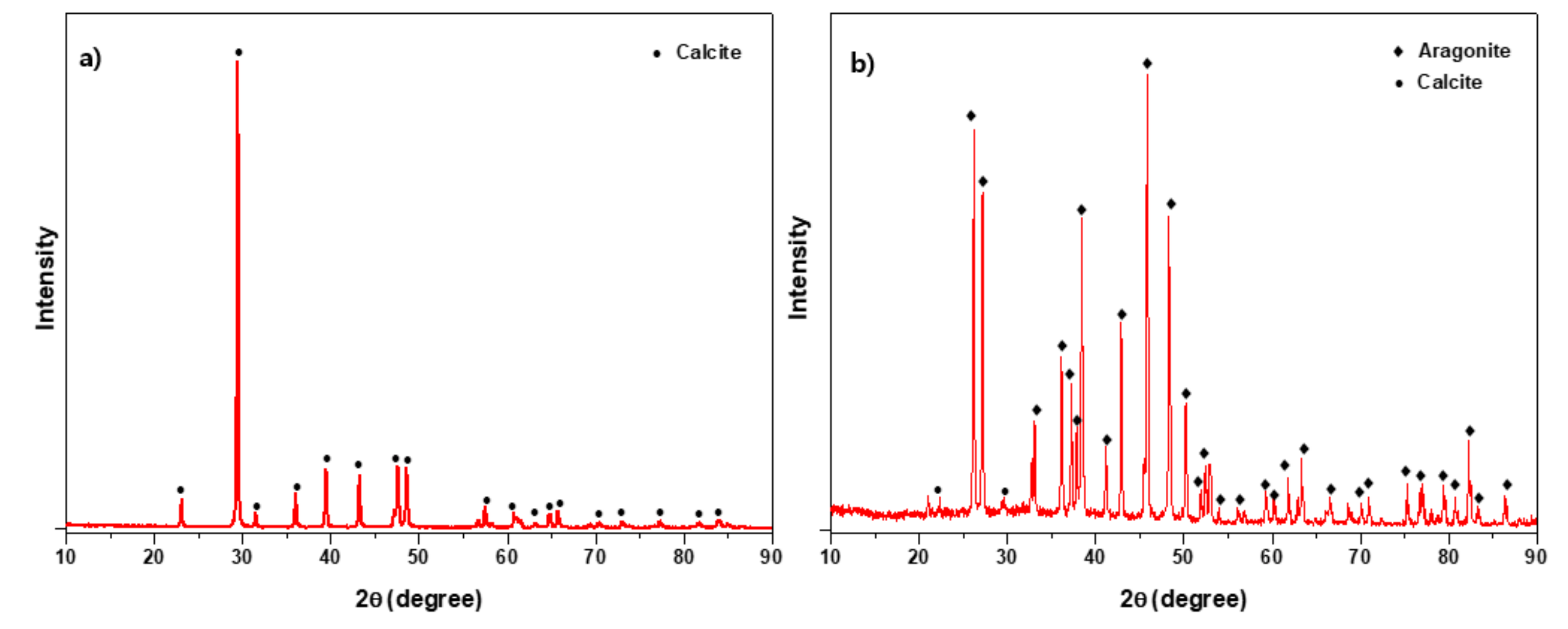

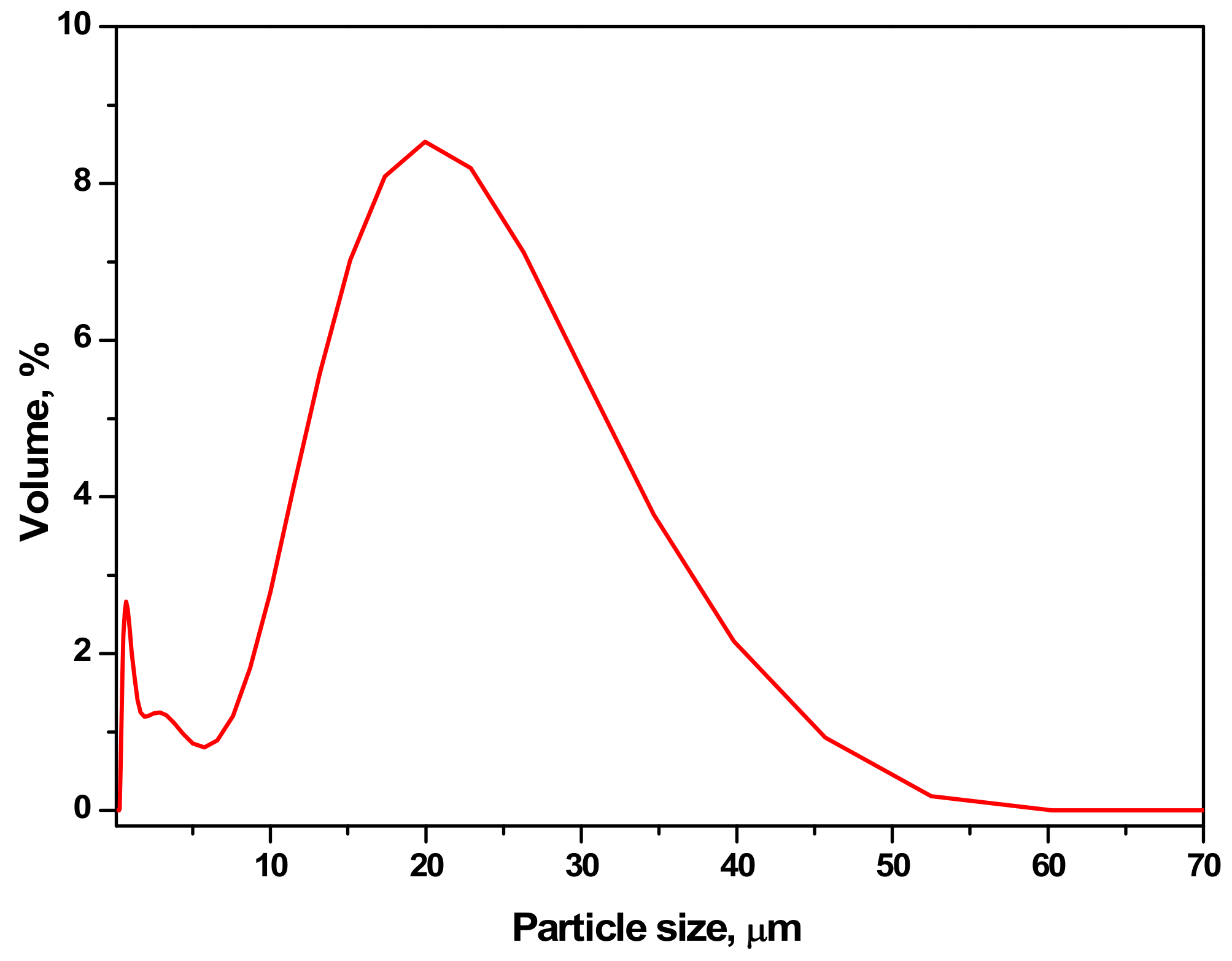



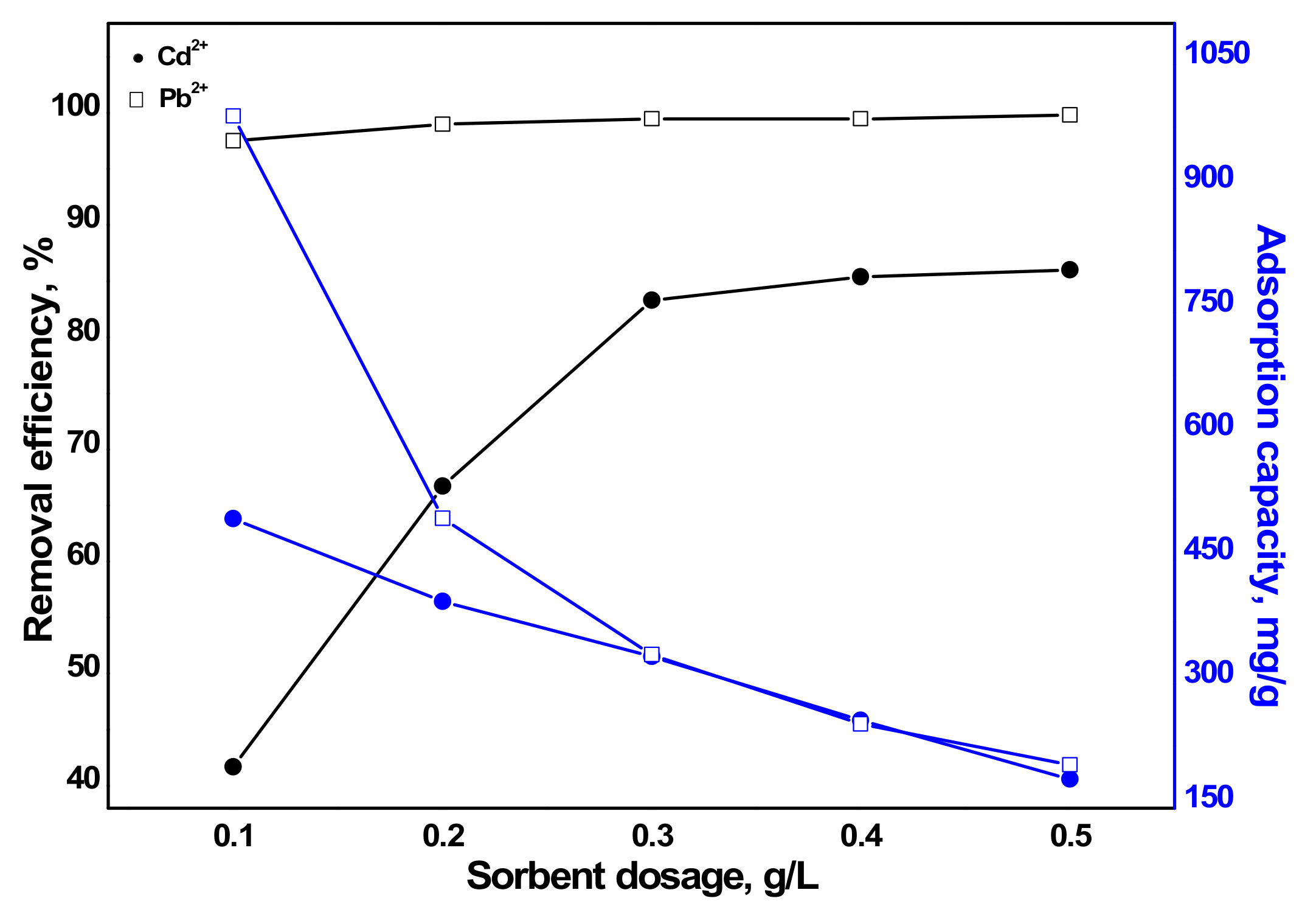

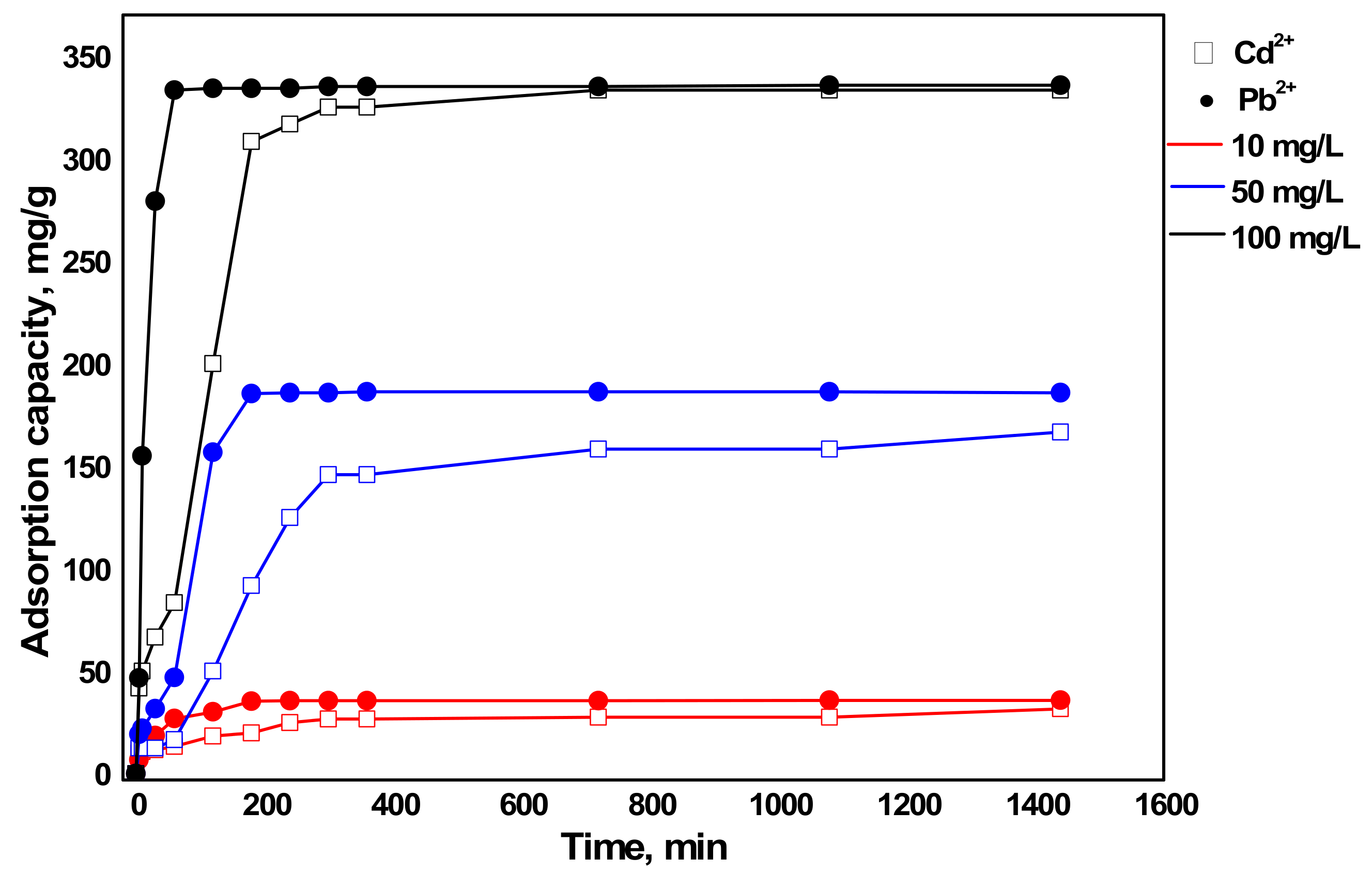
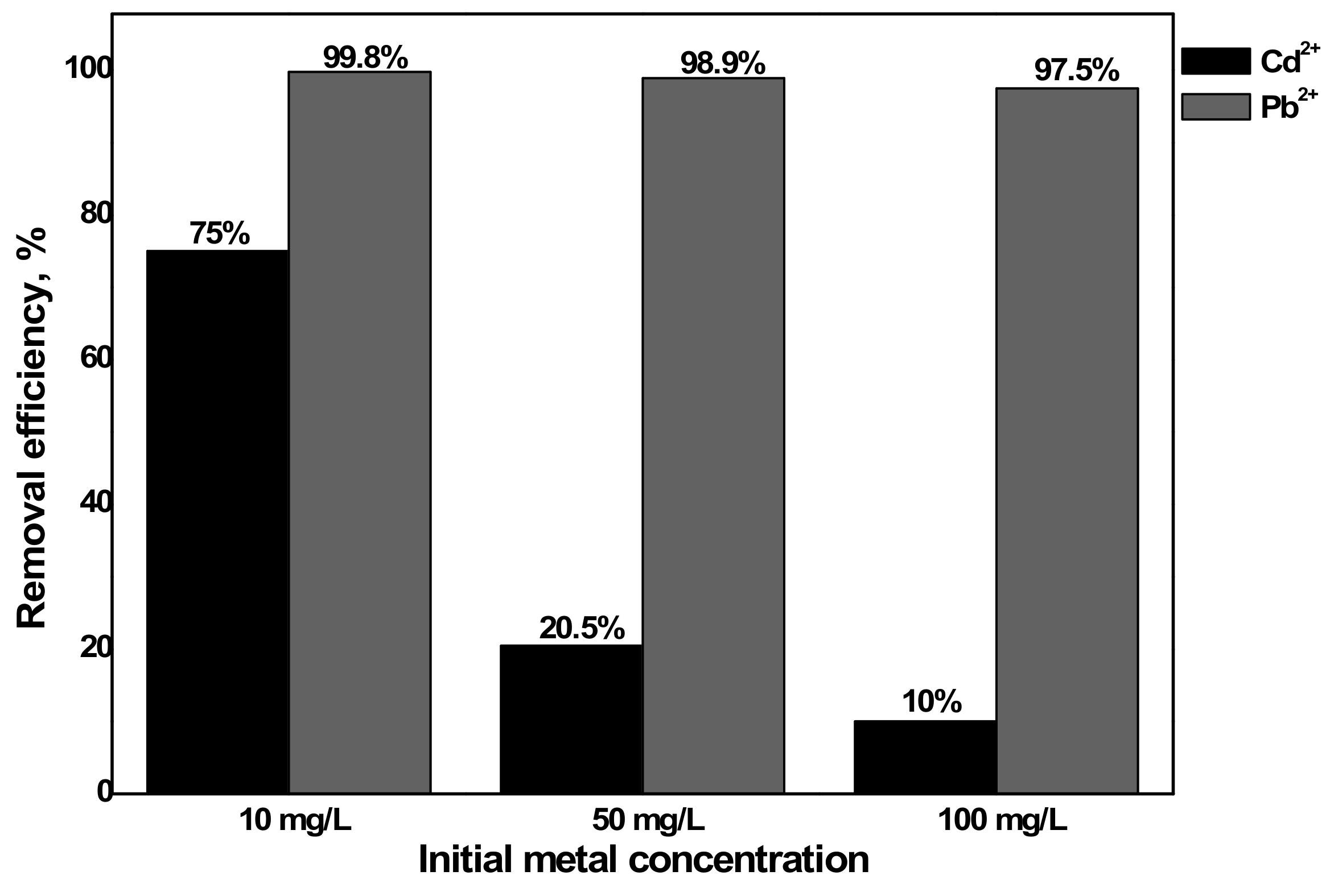
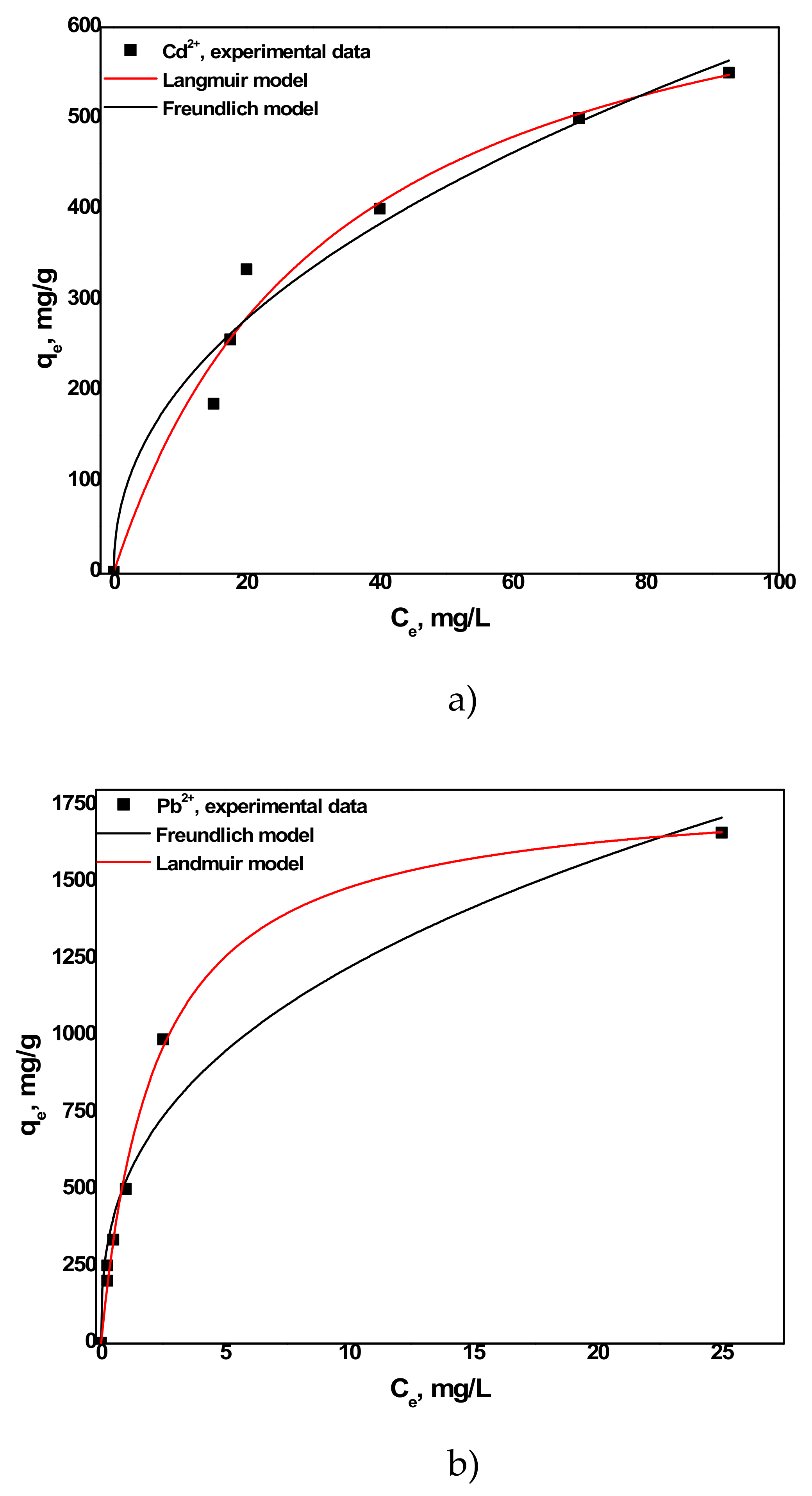
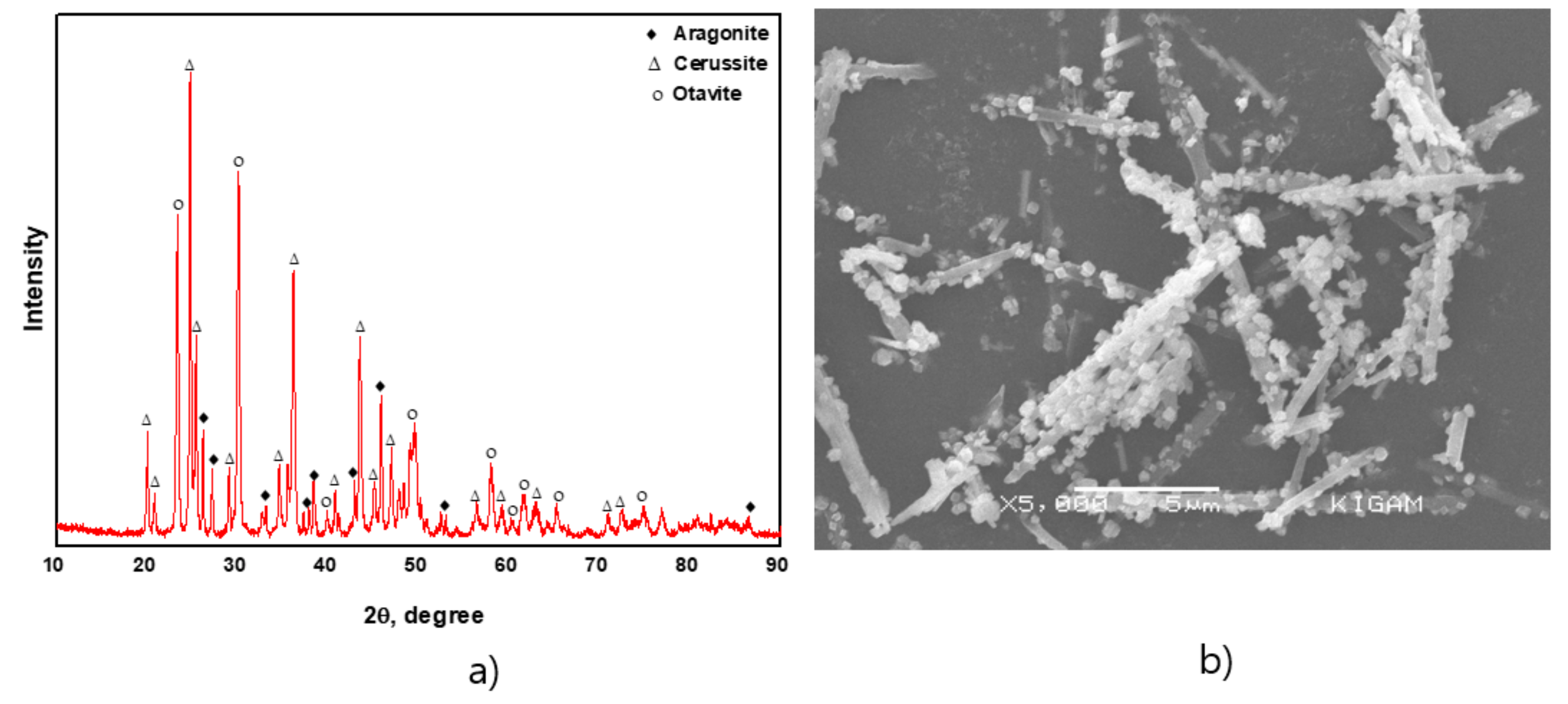
| Parameters | Values | Adsorption Capacity (mg/g) | Removal Efficiency (%) | Experimental Condition | ||
|---|---|---|---|---|---|---|
| Cd2+ | Pb2+ | Cd2+ | Pb2+ | |||
| Sorbent dosage (g/L) | 0.1 | 500 | 987.5 | 41.7 | 97.5 | Initial pH = 5.8 and Cd2+ and Pb2+ concentration = 100 mg/L |
| 0.2 | 400 | 501 | 66.7 | 99 | ||
| 0.3 | 333.3 | 335.8 | 83.3 | 99.5 | ||
| 0.4 | 256.3 | 251.9 | 85.4 | 99.5 | ||
| 0.5 | 185 | 202 | 86 | 99.8 | ||
| Initial pH | 2 | 0 | 0 | 0 | 0 | Sorbent dosage = 0.3 g/L and Cd2+ and Pb2+ = 100 mg/L |
| 3 | 175 | 276.7 | 43.8 | 82 | ||
| 4 | 316.7 | 334.2 | 79.2 | 99 | ||
| 5 | 325 | 335 | 81.3 | 99.3 | ||
| 6 | 333.3 | 335.8 | 83.3 | 99.5 | ||
| Cd2+ and Pb2+concentration (mg/L) | 10 | 34.2 | 35.8 | 80.4 | 99.1 | Sorbent dosage = 0.3 g/L and Initial pH = 6 |
| 50 | 179.2 | 185.8 | 81.1 | 99.3 | ||
| 100 | 333.3 | 335.8 | 83.3 | 99.5 | ||
| Metal | First-Order Parameters | Pseudo Second-Order Parameterser Parameters | ||||
|---|---|---|---|---|---|---|
| qe (mg g-1) | K1 (min-1) | R2 | qe (mg g-1) | K2 (g mg-1 min-1) | R2 | |
| Cd2+ | 349.55 | 0.01163 | 0.951 | 353.36 | 4.46*10^−5 | 0.986 |
| Pb2+ | 72.56 | 7.11*10^−3 | 0.617 | 338.98 | 4.23*10^−4 | 0.999 |
| Metal | Langmuir Isotherm Model Parameters | Freundlich Isotherm Model Parameters | ||||
|---|---|---|---|---|---|---|
| qmax (mg g-1) | b | R2 | Kf (mg 1−1/n g−1 L1/n) | 1/n | R2 | |
| Cd2+ | 743.59 | 0.031 | 0.986 | 70.499 | 0.404 | 0.972 |
| Pb2+ | 1807.9 | 0.454 | 0.995 | 526.88 | 0.326 | 0.955 |
| Metal | Ionic Radius (Å) | Hydration Energy (kJ/mol) | Carbonate | Ksp (25 °C) | Crystal System | Lattice Constants (Å) |
|---|---|---|---|---|---|---|
| Ca2+ | 1.18, CN=9 | −1592 | Aragonite (CaCO3) | 6.0 × 10−9 | Orthorhombic | a = 4.959, b = 7.968, c = 5.741 |
| Pb2+ | 1.35, CN=9 | −1481 | Cerussite (PbCO3) | 7.40 × 10−14 | Orthorhombic | a = 5.195, b = 8.436, c = 6.152 |
| Hydrocerussite (Pb3(CO3)2(OH)2) | 5.0 × 10−43 | Trigonal | a = b = 5.24, c = 23.74 | |||
| Cd2+ | 0.95, CN=6 | −1807 | Otavite (CdCO3) | 1.0 × 10−12 | Trigonal | a = b = 4.912, c = 16.199 |
© 2020 by the authors. Licensee MDPI, Basel, Switzerland. This article is an open access article distributed under the terms and conditions of the Creative Commons Attribution (CC BY) license (http://creativecommons.org/licenses/by/4.0/).
Share and Cite
Habte, L.; Shiferaw, N.; Khan, M.D.; Thriveni, T.; Ahn, J.W. Sorption of Cd2+ and Pb2+ on Aragonite Synthesized from Eggshell. Sustainability 2020, 12, 1174. https://doi.org/10.3390/su12031174
Habte L, Shiferaw N, Khan MD, Thriveni T, Ahn JW. Sorption of Cd2+ and Pb2+ on Aragonite Synthesized from Eggshell. Sustainability. 2020; 12(3):1174. https://doi.org/10.3390/su12031174
Chicago/Turabian StyleHabte, Lulit, Natnael Shiferaw, Mohd Danish Khan, Thenepalli Thriveni, and Ji Whan Ahn. 2020. "Sorption of Cd2+ and Pb2+ on Aragonite Synthesized from Eggshell" Sustainability 12, no. 3: 1174. https://doi.org/10.3390/su12031174
APA StyleHabte, L., Shiferaw, N., Khan, M. D., Thriveni, T., & Ahn, J. W. (2020). Sorption of Cd2+ and Pb2+ on Aragonite Synthesized from Eggshell. Sustainability, 12(3), 1174. https://doi.org/10.3390/su12031174







